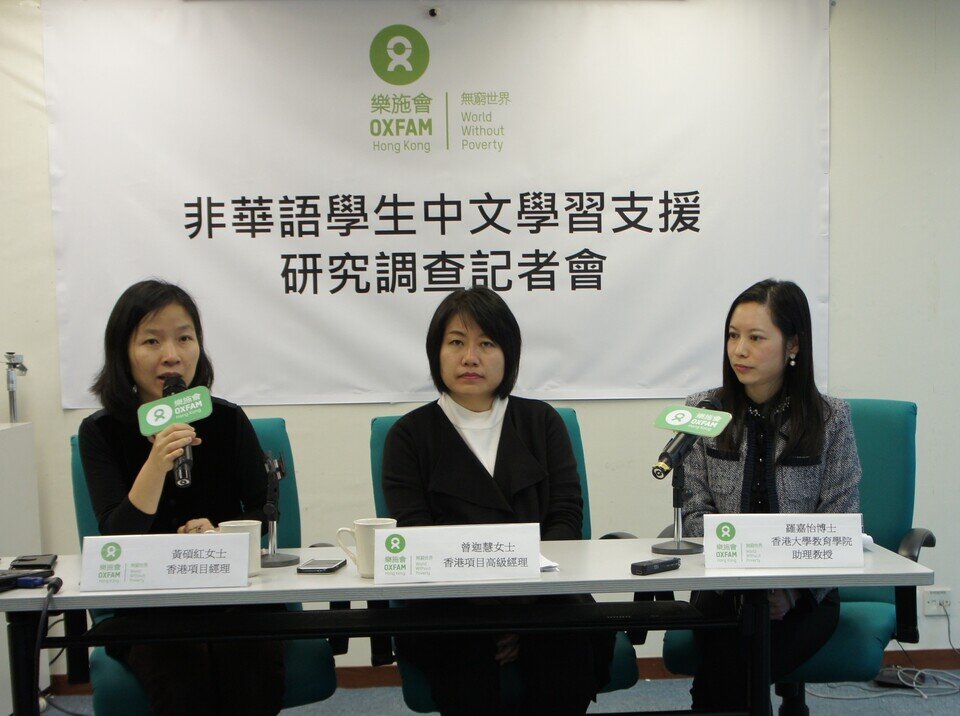07 JAN 2016
Survey on the Enhanced Chinese Learning and Teaching Support For Non-Chinese Speaking Students
Oxfam urges the Education Bureau to develop Chinese as a second language curriculum and review funding method
Oxfam recently conducted a survey on ‘Enhanced Chinese Learning and Teaching Support for Non-Chinese Speaking Students in Primary and Secondary Schools’ to evaluate the effectiveness of the Education Bureau’s ‘Chinese Language Curriculum Second Language Learning Framework’, which was implemented in the 2014/15 school year. Results from the survey showed that the ‘Learning Framework’ failed to provide non-Chinese speaking (NCS) students with appropriate and sufficient support. The lack of support was especially severe among schools that admitted fewer (i.e. nine or fewer) NCS students. Over 70 per cent of these schools did not provide NCS students with additional tailor-made support, and close to 30 per cent did not know about the funding.
Oxfam is thus urging the government to enhance learning support for schools that admit fewer NCS students. Furthermore, the Education Bureau should take up the responsibility of designing a Chinese as a second language curriculum and require more teachers to receive professional development to teach NCS students in order to cater to the learning needs of these students. The more effective the measures that support NCS students’ Chinese language learning and academic development, the higher the chance they have for a post-secondary education and the more career paths from which they can choose. This will thus prevent them from being limited to only taking up low-end jobs.1
The survey
To better understand schools’ opinions regarding the ‘Learning Framework’2, relevant policies and their effectiveness, Oxfam commissioned Policy 21 Ltd to conduct a survey on all government, subsidy, direct subsidy scheme and caput schools in Hong Kong between January and May, 2015. A total of 582 schools responded to the survey and 263 of them admitted NCS students. Furthermore, 59.3 per cent (156 schools) admitted nine or fewer NCS students, while 40.7 per cent (107 schools) admitted 10 or more NCS students. Findings:
Three quarters of the schools that admitted fewer NCS students did not apply for additional funding; close to 30 per cent did not know about the new grant
The reasons these schools gave for not applying for the funding are as follows: ‘the funding is unnecessary at the moment’ (41.5 per cent), ‘there are only a few NCS students in our school’ (29.0 per cent), and ‘not enough resources to provide support even if funding was granted’ (23.3 per cent). Furthermore, 28 per cent indicated that they did not know about the new grant; some schools even asked our interviewers how they could apply for such funding.
Over 70 per cent of schools that admitted fewer NCS students did not offer additional tailor-made Chinese learning support materials
Most of the schools that admitted fewer NCS students did not offer independent immersion Chinese classes or use adapted textbooks, teaching materials or a school-based Chinese curriculum. More specifically, among these schools, 70.6 per cent did not offer pull-out classes and only one secondary school offered parallel classes. Furthermore, 73.4 per cent did not use adapted textbooks nor had their own school-based Chinese curriculum for their NCS students.
Only 20 per cent of teachers who taught Chinese took short-term in-service training courses on teaching Chinese for NCS students
Among the teachers who taught NCS students Chinese, only 21.6 per cent took short-term in-service training courses on teaching NCS students. This percentage was much lower among teachers who taught NCS students non-Chinese subjects – just 7.2 per cent.
Close to 40 per cent of schools that admitted more NCS students felt that the new ‘Learning Framework’ could boost NCS students’ Chinese proficiency
Close to 40 per cent of schools that admitted 10 or more NCS students expressed that the new ‘Learning Framework’ is very helpful (2.7 per cent) or quite helpful (37.0 per cent) in terms of improving NCS students’ Chinese proficiency.
Schools that admitted nine or fewer NCS students were more reserved about the effectiveness of the ‘Learning Framework’. Only 20 per cent of them felt that it was very helpful or quite helpful (16.6 per cent) in terms of helping these students enhance their Chinese language standard.
A large number of schools felt that the Education Bureau should design a Chinese as a second language curriculum to improve NCS students’ Chinese proficiency
A total of 36.1 per cent of the schools felt that the Education Bureau should design a Chinese as a second language curriculum. A further 26.5 per cent felt that increasing the amount of government funding or enhancing training courses on ‘teaching Chinese as a second language’ (21.8 per cent) could effectively improve NCS students’ proficiency. A large number of schools felt that the Education Bureau should design a Chinese as a second language curriculum to improve NCS students’ Chinese proficiency
Oxfam’s recommendations
Have the Education Bureau take up responsibility to develop a more suitable Chinese as a second language curriculum for NCS students
The majority of schools believe that the best way to improve NCS students’ Chinese proficiency is to have the Education Bureau take up the responsibility of designing a Chinese as a second language curriculum (that indicates the goal of the curriculum, and includes teaching materials, and teaching and assessment methods). Oxfam urges the government to implement such a measure as we believe this can help teachers more effectively teach NCS students Chinese.
Enhance learning support in schools that admit fewer NCS students
We recommend that the government review the way in which schools that admit fewer NCS students are funded. That is, instead of having these schools apply for additional funding, the government should take the initiative to grant funding to these schools to ensure that they receive sufficient additional resources and support to help NCS students learn Chinese.
The government should also review whether the current amount of funding (HK$50,000) is sufficient to allow schools to hire extra personnel or purchase a service to provide independent Chinese immersion classes (e.g. parallel classes or pull-out classes) to help NCS students learn Chinese more effectively.
Promote professional development for teachers teaching NCS students
In order to better equip more teachers who teach NCS students, Oxfam recommends that the government take reference from the existing professional training development arrangement for teachers who teach students with special educational needs. That is, they should set up a three-tier intervention model (i.e. basic, advanced and thematic courses) and set clear goals. Schools that admit NCS students should, within a specified period of time, ensure that a certain percentage of teachers – both Chinese teachers and those who teach other subjects – have received this kind of training.
Conclusion
Oxfam has always been concerned about poverty among ethnic minorities in Hong Kong. We urge the government to improve the Chinese education policy for NCS students so that they are provided with appropriate support in their Chinese language education. Doing this can help provide them with equal opportunities to pursue a post-secondary education, allow for upward mobility, and thus enable them to escape the poverty some of them face, and even break the cycle of intergenerational poverty.
- Ends –
Notes:
1. Newly released figures in the government’s ‘Hong Kong Poverty Situation Report on Ethnic Minorities 2014’ show that the estimated poverty rate among South Asian households with children stand at 30.8 per cent – higher than the city-wide average of 16.2 per cent. Furthermore, the report indicated that the lack of proficiency in Chinese was one of the main obstacles keeping many ethnic minority people from escaping poverty.
2. In the 2014/15 school year, the Education Bureau implemented a new measure to support ethnic minority students’ Chinese language learning called the ‘Chinese Language Curriculum Second Language Learning Framework’, which sets out various levels of learning and their respective expected learning outcomes. Although this framework was developed from the perspective of NCS students, it takes reference from the current Chinese curriculum, which assumes that students’ mother tongue is Chinese. Besides this framework, the Education Bureau also provides subsidies of between HK$800,000 and HK$1.5 million to schools that admit 10 or more NCS students, while schools that admit nine or fewer may apply for HK$50,000 in funding every year. The Education Bureau also introduced the ‘Professional Enhancement Grant Scheme for Chinese Teachers (Teaching Chinese as a Second Language)’.
About Oxfam
Oxfam is a worldwide development organisation that mobilises the power of people against poverty.
For media enquiries, please contact:
Wong Shek-hung | Clara Law |
Wong Shek-hung, Oxfam’s Hong Kong Programme Manager (left) and Kalina Tsang, Senior Manager of Oxfam’s Hong Kong Programme (right) urge the Education Bureau to develop Chinese as a second language curriculum and review funding method.
Wong Shek-hung, Oxfam’s Hong Kong Programme Manager (left) and Kalina Tsang, Senior Manager of Oxfam’s Hong Kong Programme (right) urge the Education Bureau to develop Chinese as a second language curriculum and review funding method.
Dr. Ka Yee Loh, Assistant Professor of The University of Hong Kong Faculty of Education has been researching on learning Chinese as Second Language Curriculum, she pointed out that among the schools admitted NCS students, most of them admitted nine or fewer, however the Government support to these schools are not enough.



